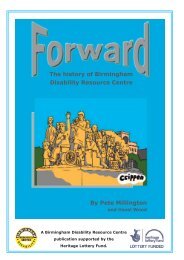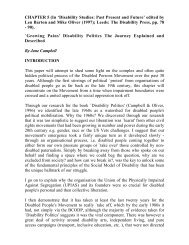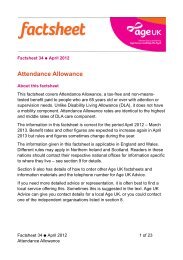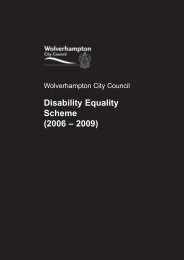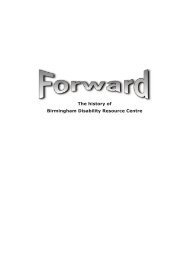What equality law means - Birmingham Disability Resource Centre
What equality law means - Birmingham Disability Resource Centre
What equality law means - Birmingham Disability Resource Centre
You also want an ePaper? Increase the reach of your titles
YUMPU automatically turns print PDFs into web optimized ePapers that Google loves.
For example:<br />
• Supervisors in an organisation are usually employed on a full-time basis. The<br />
employer agrees to a disabled person whose impairment causes severe fatigue<br />
working on a part-time or job share basis. By doing this, the employer is making a<br />
reasonable adjustment.<br />
• The design of a particular workplace makes it difficult for a disabled person with<br />
a hearing impairment to hear, because the main office is open plan and has<br />
hard flooring, so there is a lot of background noise. Their employer agrees<br />
that staff meetings should be held in a quieter place that allows that person<br />
to fully participate in the meeting. By doing this, the employer is making a<br />
reasonable adjustment.<br />
Dealing with physical barriers<br />
The second requirement involves making changes to overcome barriers created by the<br />
physical features of your workplace.<br />
This <strong>means</strong> you may need to make some changes to your building or premises for a<br />
disabled person who works for you, or applies for a job with you.<br />
Exactly what kind of change you make will depend on the kind of barriers your premises<br />
present. You will need to consider the whole of your premises. You may have to make<br />
more than one change.<br />
Physical features include: steps, stairways, kerbs, exterior surfaces and paving, parking<br />
areas, building entrances and exits (including emergency escape routes), internal and<br />
external doors, gates, toilet and washing facilities, public facilities (such as telephones,<br />
counters or service desks), lighting and ventilation, lifts and escalators, floor coverings,<br />
signs, furniture, and temporary or movable items (such as equipment and display racks).<br />
Physical features also include the sheer scale of premises (for example, the size of a<br />
building). This is not an exhaustive list.<br />
• A physical feature could be something to do with the structure of the actual building<br />
itself like steps, changes of level, emergency exits or narrow doorways.<br />
• Or it could be something about the way the building or premises have been fitted out,<br />
things like heavy doors, inaccessible toilets or inappropriate lighting.<br />
• It could even be the way things are arranged inside the premises such as fixtures and<br />
fittings like shelf heights in storage areas or fixed seating in canteens.<br />
55




